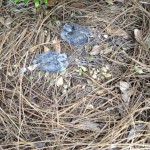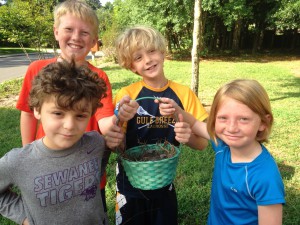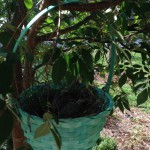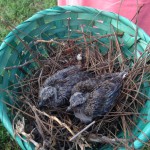
These fledgling doves were found out of their nest and on the ground in late May. Photo credit: Carrie Stevenson
A few weeks ago, the neighbor boys came running over to show my children the baby birds they found in their front yard. We expected they would lead us to a tree and point out fledglings in a nest, but instead the young mourning doves were lying on the ground in a pile of pine straw. Their nest had fallen from a perch in a low windowsill. According to the local Wildlife Sanctuary of Northwest Florida, mourning doves are notoriously bad nest-makers.
So, with no regard to the (untrue) wives’ tale that human scent affects a mother bird’s willingness to return to her babies, I scooped up the birds and kept them in a box inside for the night. Our neighborhood has plenty of roving cats, raccoons, and even coyotes, so this protected the vulnerable young birds from predators.
The next morning, the kids and I made a new perch for the birds from an old basket by placing the nest inside it and hanging it from a nearby tree. At that point, we left the area alone, so as not to frighten the mother bird away. Within hours, she was back, fussing around the nest and bringing food.

Establishing a conservation ethic towards land, water, and wildlife while children are young will ensure good stewardship for generations to come! Photo credit: Carrie Stevenson
This happy ending illustrates a an important point—trust nature! Often, out of well-intended concern, people bring young (uninjured) animals to a wildlife sanctuary simply because they are afraid they’ve been abandoned. If young are moved, their parents will never find them again. While rehabilitation facilities do their best to return wildlife to their native habitat, there is no substitute for a young animal to learn to find food, hide, or fly from their own kin. In our situation, we intervened enough to keep the birds safe from predators, but didn’t completely relocate them from their home.
It was a lesson that these four budding wildlife conservationists will never forget.
- Wax Myrtle–a Native Evergreen - December 26, 2025
- Yucca–A Tough and Versatile Native Plant - November 26, 2025
- Blazing Star - November 6, 2025


